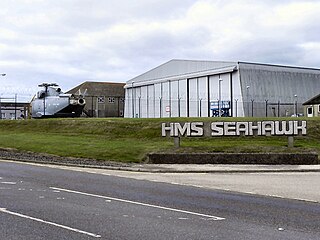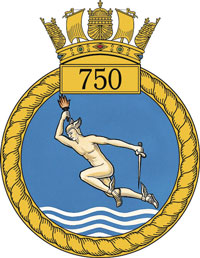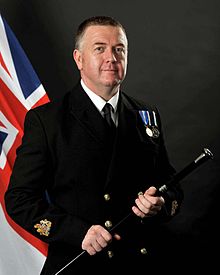
The Fleet Air Arm (FAA) is one of the five fighting arms of the Royal Navy and is responsible for the delivery of naval air power both from land and at sea. The Fleet Air Arm operates the F-35 Lightning II for maritime strike, the AW159 Wildcat and AW101 Merlin for commando and anti-submarine warfare and the BAE Hawk as an aggressor.

Royal Naval Air Station Yeovilton, or RNAS Yeovilton, is an airfield of the Royal Navy and British Army, sited a few miles north of Yeovil, Somerset. It is one of two active Fleet Air Arm bases and is currently home to the Royal Navy Wildcat HMA2 and Army Air Corps Wildcat AH1 helicopters as well as the Royal Navy's Commando Helicopter Force Merlin HCi3/4/4A and Wildcat AH1 helicopters.

849 Naval Air Squadron was a squadron of the Fleet Air Arm, the Air Arm of the British Royal Navy. It was formed during the Second World War as a carrier based torpedo-bomber, unit, flying missions against Japanese targets in the Far East. Its service since the Second World War has been as an airborne early warning squadron, flying fixed winged Skyraiders and Gannets from the Royal Navy's fixed wing carriers from 1952 until 1978, and airborne early warning Sea King helicopters from 1982 to 2018.

The Commander-in-Chief Fleet (CINCFLEET) was the admiral responsible for the operations of the ships, submarines and aircraft of the British Royal Navy from 1971 until April 2012. The post was subordinate to the First Sea Lord, the professional head of the Naval Service. In its last years, as the Navy shrank, more administrative responsibilities were added.

Royal Naval Air Station Culdrose is a Royal Navy airbase near Helston on the Lizard Peninsula of Cornwall UK, and is one of the largest helicopter bases in Europe. Its main role is serving the Fleet Air Arm's front line AgustaWestland Merlin helicopter squadrons.

An Aircraft Handler is a member of the Aircraft Handling branch in the Royal Navy of the UK Armed Forces. Aircraft Handlers are responsible for the safe movement, launching and recovering (landing) of all aircraft onboard ships within the Royal Navy and some of the Royal Fleet Auxiliary. They are also responsible for aircraft crash rescue fire fighting duties on board Royal Navy ships and at Royal Naval Air Stations. The Aircraft Handling branch of the Fleet Air Arm in the Royal Navy was formed in 1945. Beforehand the duties of Aircraft Handlers were performed by members of other branches of the Royal Navy, many of whom transferred to the new branch upon its formation.

700 Naval Air Squadron is an experimental test squadron in the Royal Navy’s Fleet Air Arm.

848 Naval Air Squadron was a squadron of the Royal Navy Fleet Air Arm. It operated the Westland Sea King HC.4 helicopter and previously provided advanced flying training to pilots for the other squadrons in the Commando Helicopter Force. The squadron was based at RNAS Yeovilton in Somerset and was decommissioned on 24 March 2016.

771 Naval Air Squadron of the Fleet Air Arm was formed on 24 May 1939 at Lee-on-Solent as a Fleet Requirements Unit with 14 Fairey Swordfish TSR biplanes. The Squadron carried out various exercises with ships and provided towed targets for naval air gunners and was decommissioned on 22 March 2016.

The Royal Navy Observer School grew out of HM Naval Seaplane Training School at RNAS Lee-on-Solent as a result of a series of changes of identity and parent unit. From 1918 until 1939 the Royal Air Force was responsible for naval aviation, including training and provision of aircrew to the Royal Navy. With the return of naval aviation to the Royal Navy on 24 May 1939, the Observer School was established as 750 Naval Air Squadron of the Fleet Air Arm. During World War II the squadron moved to Trinidad to continue training aircrew. It was temporarily disbanded in October 1945. The squadron reformed in 1952 and is currently based at RNAS Culdrose, where it trains approximately 30 Royal Navy observers every year.

727 Naval Air Squadron is a squadron of the Royal Navy Fleet Air Arm. It was formed in 1943 as a Fleet Requirements Unit, being disbanded in December 1944. It was reformed twice in the 1940s and 1950s to provide flying experience for naval officers. The current squadron was created on 6 Dec 2001 from the Royal Naval Flying Training Flight. It operates the Grob Tutor, with its primary role to provide grading and legacy-Elementary Flying Training for Royal Navy and Royal Marine pilots under training. It also supports the Royal Navy's "Flying Start" flying scholarship scheme.

815 Naval Air Squadron is a squadron of the Fleet Air Arm, part of the Royal Navy, based at RNAS Yeovilton in Somerset; it is the Navy's front line Wildcat Naval Air Squadron. It comprises AgustaWestland Wildcat HMA.2 helicopters and is the largest helicopter squadron in western Europe.
The Fleet Requirements and Air Direction Unit (FRADU) was a unit of the Royal Navy's Fleet Air Arm operated by the contractor Serco Defence and Aerospace. It was established in 1972. It was most recently equipped with 13 BAE Systems Hawk T1 advanced jet trainer aircraft on lease to the Royal Navy from the Royal Air Force, based at RNAS Culdrose in Cornwall. Two of these aircraft were permanently detached to Naval Flying Standards Flight at RNAS Yeovilton where they are flown by RN pilots, but maintained by Serco engineers.

736 Naval Air Squadron was a Naval Air Squadron of the Royal Navy. It was most recently recommissioned at RNAS Culdrose on 6 June 2013 to fly the BAE Systems Hawk T1, following the disbandment of the Fleet Requirements and Aircraft Direction Unit (FRADU) and operated up until March 2022.

814 Naval Air Squadron or 814 NAS, nicknamed the Flying Tigers, is a squadron of the Royal Navy Fleet Air Arm. It is currently equipped with the AgustaWestland Merlin HM2 anti-submarine warfare helicopter and is based at Royal Naval Air Station (RNAS) Culdrose in Cornwall. The squadron was formed in December 1938 and has been disbanded and reformed several times.

705 Naval Air Squadron was first formed as a flight in 1936 from No 447 Flight Royal Air Force and operated Swordfish torpedo bombers from battlecruisers. It achieved squadron status in 1939 before being disbanded in 1940. The squadron was re-formed briefly in 1945 and then again in 1947 as a fleet requirements unit to evaluate naval use of helicopters. Since the 1950s the squadron has been involved in the basic training of helicopter aircrew, and currently forms part of No. 1 Flying Training School at RAF Shawbury.

824 Naval Air Squadron is a Royal Navy Fleet Air Arm squadron based at RNAS Culdrose and currently operating the AgustaWestland Merlin HM2 Operational Conversion Unit. It trains aircrew in Anti-Submarine warfare

HMS Gannet is a forward operating base of the Royal Navy's Fleet Air Arm located at Glasgow Prestwick Airport, South Ayrshire in Scotland.
The History of Royal Navy Helicopter Search and Rescue has its roots in the adoption by the Royal Navy of helicopters in the plane guard role. From a purely military tasking Royal Navy squadrons came to share the provision of search and rescue SAR coverage for the United Kingdom with the Royal Air Force and commercial providers under contract to Her Majesty's Coastguard, being responsible for two sectors out of twelve. From 2015 both the RAF and the Navy will surrender the civilian SAR role to contractors operating on behalf of the Coastguard.

















